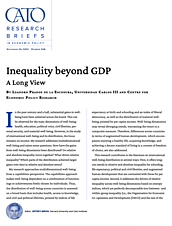My research approaches multidimensional well-being from a capabilities perspective. The capabilities approach makes well-being dependent on a combination of functionings or achievements freely chosen by individuals. Thus, the distribution of well-being across countries is assessed on a broad basis that includes health, access to knowledge, and civil and political liberties, proxied by indices of life expectancy at birth and schooling and an index of liberal democracy, as well as the distribution of material wellbeing, proxied by per capita income. Well-being dimensions may reveal diverging trends, warranting the resort to a composite measure. Therefore, differences across countries in terms of augmented human development, which encompasses enjoying a healthy life, acquiring knowledge, and achieving a decent standard of living in a context of freedom of choice, are also addressed.
This research contributes to the literature on international well-being distribution in several ways. First, it offers long-run trends in relative and absolute inequality for schooling, life expectancy, political and civil liberties, and augmented human development that are contrasted with those for per capita income. Second, it addresses the drivers of relative inequality across well-being dimensions based on entropy indices, which are perfectly decomposable into between- and within-group inequality (i.e., the Organisation for Economic Co-operation and Development [OECD] and the rest of the world). Finally, it shows the distribution of relative and absolute gains in well-being dimensions by deciles using growth incidence curves. The period considered spans from 1870 to 2015, encompassing two phases of globalization (pre-1913 and post-1950) and one of globalization backlash (1914–1950), based on a sample ranging between 115 and 162 countries that represents most of the world’s population.
The main results challenge the conventional view of the well-being distribution across countries and over time that derives from gross domestic product per head. While the international dispersion of per capita income increased until the late 20th century and only fell since 1990, relative inequality in health and education fell steadily since the late 1920s and, in terms of political and civil liberties, unweighted inequality experienced a long-run decline since 1890, but population-weighted inequality grew over time, only dropping from 1970 onward. Relative inequality in augmented human development declined since 1900, with schooling and political and civil liberties as the main contributors, although longevity played a distinctive part up to the 1920s. The gap between the OECD and the rest of the world accounted only partially for relative inequality in well-being since the dispersion within developing regions became its main driver from the mid-20th century onward. Relative and absolute well-being distribution behaved differently. For most of the timespan considered, the relative distance across countries shrank, but the absolute distance widened. A look at the long-run distribution of well-being reveals relative gains for those countries in the middle and lower deciles over the past century. The globalization of primary and secondary schooling and the health transition mainly accounted for the reduction of population-weighted inequality in terms of well-being, although the rise of authoritarian political regimes partly offset it, since civil and political liberties only helped reduce well-being inequality from the late 20th century.
Note
This research brief is based on Leandro Prados de la Escosura, “Inequality beyond GDP: A Long View,” Centre for Economic Policy Research Discussion Paper no. 15853, February 2021, https://cepr.org/active/publications/discussion_papers/dp.php?dpno=15853.

